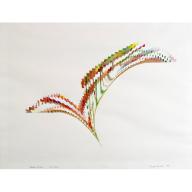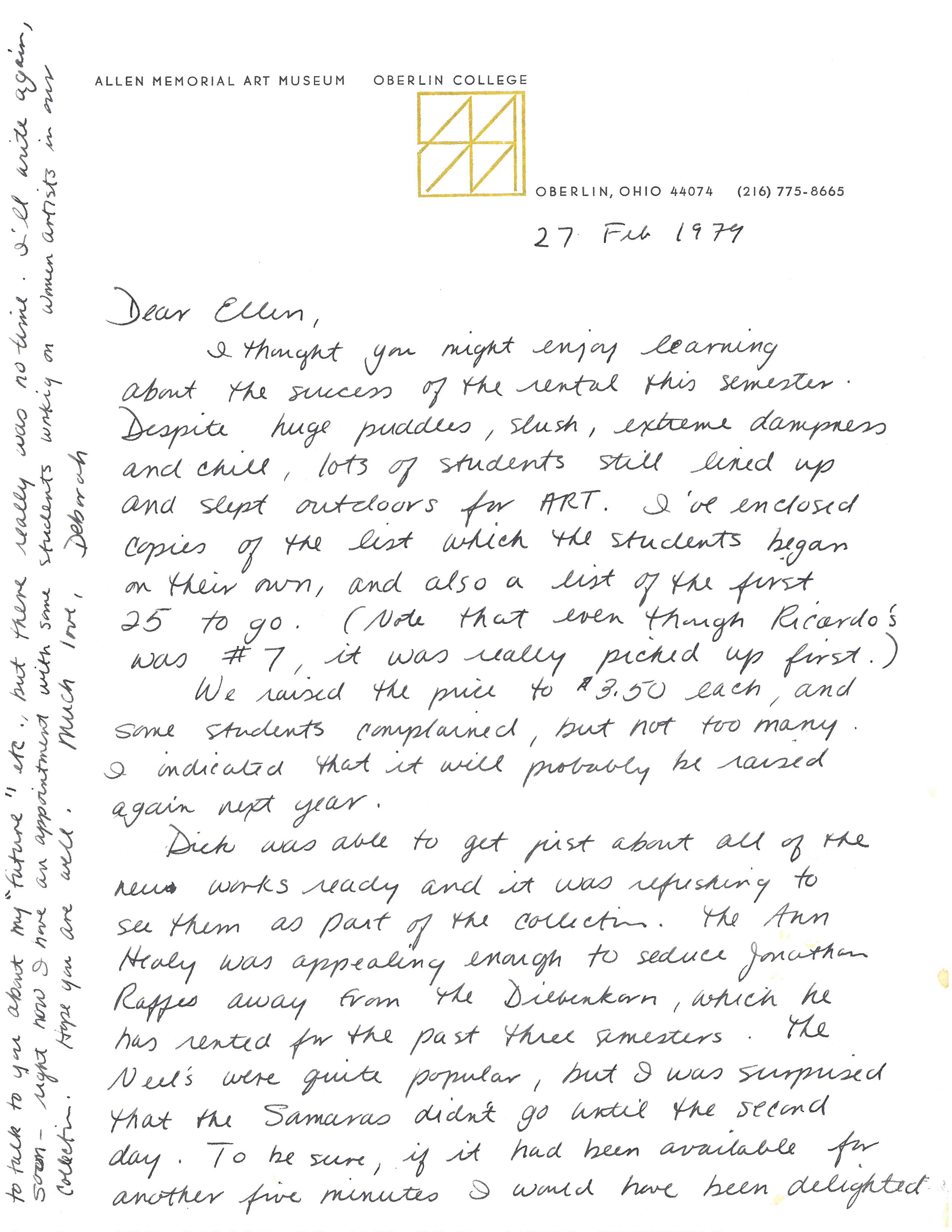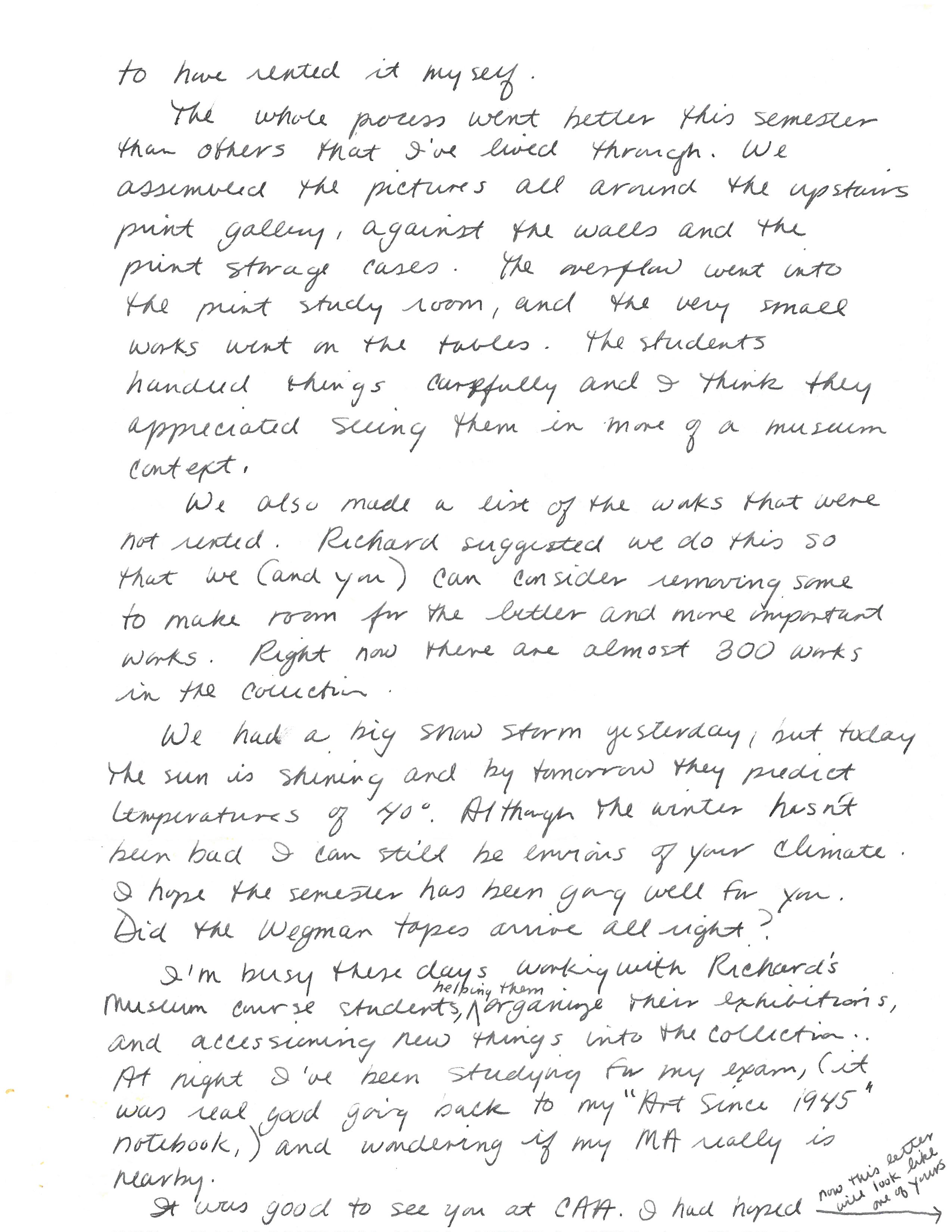“You were made of the stuff that makes legends”: The life and legacy of Ellen H. Johnson
Document 1: Survey of Potential Faculty and Administrative Contributions to a Program of Women’s Studies | Document 2: Interview with Richard Spear | Document 3: Letter from Deborah | Document 4: An Open Letter to Ellen | Bibliography
|
|
Transcription: [Letterhead] Allen Memorial Art Museum Oberlin College Oberlin, Ohio 44074 (216) 775-8665 27 Feb 1979 Dear Ellen,  I thought you might enjoy learning about the success of the rental[3] this semester. Despite huge puddles, slush, extreme dampness and chill, lots of students still lined up and slept outdoors for ART.[4] I’ve enclosed copies of the list which the students began on their own, and also a list of the first 25 to go. (Note that even though Ricardo’s[5] was #7, it was really picked up first.) We raised the price to $3.50 each, and some students complained, but not too many. I indicated that it will probably be raised again next year.  Source Dick was able to get just about all of the new works ready and it was refreshing to see them as part of the collection. The Ann Healy[6] was appealing enough to seduce Jonathan Raffes[7] away from the Diebenkorn,[8] which he has rented for the past three semesters. The Neel’s[9] were quite popular, but I was surprised that the Samaras[10] didn’t go until the second day. To be sure, if it had been available for another five minutes I would have been delighted to have rented it myself. The whole process went better this semester than others that I’ve lived through. We assembled the pictures all around the upstairs print gallery, against the walls and the print storage cases. The overflow went into the mint study room, and the very small works went on the tables. The students handled things carefully and I think they appreciated seeing them in more of a museum context. We also made a list of the works that were not rented. Richard[11] suggested we do this so that we (and you) can consider removing some to make room for the better and more important works. Right now there are almost 300 works in the collection.  We had a big snow storm yesterday, but today the sun is shining and by tomorrow they predict temperatures of 40°. Although the winter hasn’t been bad I can still be envious of your climate. I hope the semester has been going well for you. Did the Wegman tapes[12] arrive all right? I’m busy these days working with Richard’s museum course[13] students, [inserted above the line: ^helping them] organize their exhibitions, and accessioning new things into the collection. At night I’ve been studying for my exam, (it was real good going back to my “Art Since 1945”[14] notebook,) and wondering if my MA is really nearby. It was good to see you at CAA.[15] I had hoped ——–> (inserted above the line: now this letter will look like one of yours) to talk to you about my “future” etc., but there really was no time. I’ll write again, soon — right now I have an appointment with some students working on women artists in our collection. Hope you are well. Much love, Deborah[16] [Proofed with Louise Wurzelbacher May 2, 2016] |
[1] Ellen Johnson, Fragments Recalled at Eighty: The Art Memoirs of Ellen H. Johnson, ed. Athena Tacha (Estate of Ellen Johnson, 1993), 142.
[2] Ellen Johnson, Fragments Recalled at Eighty, 31.
[3] Art Rental.
[4] The success of Art Rental in spite of Ohio winters made it into Johnson’s memoir. She wrote, “Artists are invariably amazed and thrilled to hear how Oberlin students (not just art majors, but physicists, historians, pianists and football players) stand in line for hours before rental begins in order to get one of their choices from the collection … Some students are so filled with desire that they camp out all night, even in February in Ohio.” Ellen Johnson, Fragments Recalled at Eighty, 32.
[5] Likely Ricardo Barreto’s Chlam Balam, a watercolor collage part of the Art Rental Collection Fund. Allen Memorial Art Museum, Source, 3 May 2016.
[6] Unable to find exact sketch or painting by Ann Healy, because Allen Art Museum owns over 100.
[7] Raffe received his B.A. in art history from Oberlin College in 1979.
[8] Likely Study for “Woman by a Large Window,” 1957 by Richard Diebenkorn, both in the Museum’s collection. Johnson sold Woman by a Large Window to The Cleveland Museum in 1968 for $65,000 for the down-payment on the Frank Lloyd Wright House in which she lived until her death, when the building was donated to Oberlin College. Johnson wrote,“That’s the only work of art I ever sold and it was a horrible feeling.” Later she wrote, “I was lucky enough to find a gem of a Diebenkorn watercolor … which I let Oberlin’s rental collection have.” Allen Memorial Art Museum, Source, 4 May 2016; Ellen Johnson, Fragments Recalled at Eighty, 42.
[9] Either Olivia or Portrait of Benny Andrews by Alice Neel, both part of the Art Rental collection. Olivia was a gift to the museum from Johnson. Neel also painted Portrait of Ellen Johnson in 1976, which can be seen in the Introduction of this mini-edition. Allen Memorial Art Museum, Source, 4 May 2016.
[10] Likely Matrix Drawing #8 (April 13, 1975) by Lucas Samara. Allen Memorial Art Museum, Source, 4 May 2016.
[11] Likely Richard Spear, an art history professor at Oberlin from 1965 to 2000, and Johnson’s close friend.
[12] Likely referring to Will Wegman, a prominent photographer at the time, known for his photographs of Weimaraner dogs.
[13] Likely a course Johnson also taught, which was designed to bring students in close proximity to the works of art. This class was for no credit, and was a precursor to the Experimental College (ExCo), student- and community member-taught classes for one or two credits, at Oberlin.
[14] One of the courses Johnson taught.
[15] Likely the annual meeting of the College Art Association.

